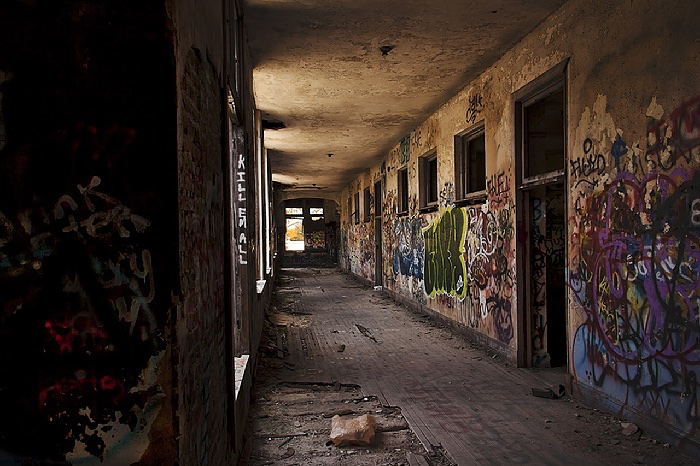A survey of the condition of US public schools in 2012/13 by the National Center for Education Statistics found that "53 percent of public schools needed to spend money on repairs, renovations, and modernizations to put the school's onsite buildings in good  overall condition" amounting to a total shortfall of $197 billion.
overall condition" amounting to a total shortfall of $197 billion.
students struggle to concentrate in schools with poor ventilation, heating, and air conditioning — problems that can lead to "Sick Building Syndrome." SBS can cause headache, eye, nose, or throat irritation, dizziness, nausea, fatigue, and dry cough, according to the EPA.

The children at Luther Burbank Middle School in California have to share outdated textbooks that they are unable to take home. Their classrooms are infested with vermin and roaches and do not have computers. There is no librarian so the library is out of date and seldom open. Only one bathroom out of three is available to students but it is locked for part of the day and it often lacks toilet paper, soap and towels. More than a third of the 35 teachers are not certified and half have been teaching at the school less than a year. Children have to wear coats, hats and gloves in class during the winter to keep warm.
 In Californian schools hundreds of thousands of children are “trying to learn in overcrowded, out-of-date [and] unsafe classrooms” or “in temporary trailers” on the school playgrounds. Almost one thousand schools have classes scheduled all year so students can attend school in staggered shifts. Court documents detailed schools where there were no chemicals for chemistry labs, no books for literature classes, and no computers for computer classes – where the teacher explained what they would be doing if they had computers – and classrooms without enough seats for all the children attending.
In Californian schools hundreds of thousands of children are “trying to learn in overcrowded, out-of-date [and] unsafe classrooms” or “in temporary trailers” on the school playgrounds. Almost one thousand schools have classes scheduled all year so students can attend school in staggered shifts. Court documents detailed schools where there were no chemicals for chemistry labs, no books for literature classes, and no computers for computer classes – where the teacher explained what they would be doing if they had computers – and classrooms without enough seats for all the children attending.
In 2003 3,800 teachers and 9,000 other school employees were retrenched in California as part of school budget cuts occurring across the nation.
 In Kansas school funding shortages have caused teachers and school librarians to be retrenched, classrooms to be closed, guidance counsellors, art teachers and Spanish teachers to be ditched, and intramural basketball games cancelled. Some schools claim they can no longer afford textbooks or air conditioning, others have reduced the school week to four days to save money. A district court judge found in 2004 that Kansas public schools were under-funded by at least $1 billion.
In Kansas school funding shortages have caused teachers and school librarians to be retrenched, classrooms to be closed, guidance counsellors, art teachers and Spanish teachers to be ditched, and intramural basketball games cancelled. Some schools claim they can no longer afford textbooks or air conditioning, others have reduced the school week to four days to save money. A district court judge found in 2004 that Kansas public schools were under-funded by at least $1 billion.
In Texas, officials were considering cuts in extracurricular activities, elective subjects, teachers, counsellors and nurses.
Lack of funding in US schools has led to a dramatic increase in uncertified teachers. There are 47,000 uncertified teachers in California alone, mainly in schools catering to working class and minority students. In Baltimore, more than one in three teachers is uncertified.
In Oregon 84 school districts out of 198 were forced to close schools up to 3 weeks before the scheduled end of the year in 2003 as they had run out of money to operate because of state education budget cuts. The days were reinstated the following year but hundreds of teacher and librarian positions were cut. State government legislation passed in August 2003 to raise taxes to cover the budget shortfall had been repealed by a ballot measure launched by corporate front group Citizens for a Sound Economy (CSE). CSE – whose funders include General Electric, Exxon Mobil, General Motors, Eli Lilli and Shell – spent half a million dollars campaigning for the measure.
in 2003 as they had run out of money to operate because of state education budget cuts. The days were reinstated the following year but hundreds of teacher and librarian positions were cut. State government legislation passed in August 2003 to raise taxes to cover the budget shortfall had been repealed by a ballot measure launched by corporate front group Citizens for a Sound Economy (CSE). CSE – whose funders include General Electric, Exxon Mobil, General Motors, Eli Lilli and Shell – spent half a million dollars campaigning for the measure.
Outside of Oregon the length of the school year is often specified by law so that schools have had to use other measures to cut costs to cope with an estimated $50-80 billion public education budget shortfall nationwide. In Boston 800 teachers lost their jobs.
In Arizona, Louisiana, Colorado and Wisconsin, four-day school weeks were introduced and in Oklahoma, teachers had to do janitor duties.
Other schools have cut costs by increasing class sizes (and therefore reducing the number of teachers employed), cancelling summer and after school programs, closing libraries and not holding school plays, increasing the cost of non-educational services such as school lunches, reducing non-teaching employees such as janitors and cafeteria workers. Families are being asked to supply  basic stationary – paper and pencils – and even soap.
basic stationary – paper and pencils – and even soap.
In 2013, the Chicago School system, which has a deficit of a billion dollars, has resorted to closing 49 elementary schools "in the largest round of school closures that a single American city has ever attempted".
If you have any examples or updates you would like to contribute please email them to me and I will add them here. Please give references for where you sourced the information.